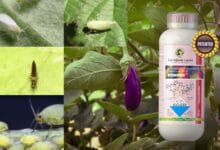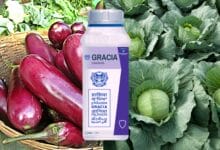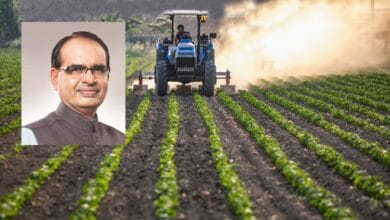Hamla Insecticide: A Popular and Old Name for all Grdeners

Hamla Insecticide Review
Price
Availability
Compatibility
Durability
Excellent
It works well on almost all crops to controls sucking and chewing pests.
Hamla Insecticide: Comprehensive Guide
In the world of agriculture, effective pest management is crucial to ensuring healthy crops and sustainable farming practices.
Among the many insecticides available in the market, the Hamla Insecticide has emerged as a reliable choice for farmers. Nowadaysmost gardeners are searching Hamla Online to keep their plants safe from insects.
This article provides an in-depth look at Hamla insecticide, including its chemical composition, benefits, recommended crops, target insects, application doses, frequently asked questions, and alternative products.
Hamla Chemical Composition
Hamla insecticide is a broad-spectrum pesticide formulated to combat a range of agricultural pests. Its active ingredients include:
- Lambda-cyhalothrin: A synthetic pyrethroid that disrupts the nervous system of insects, leading to paralysis and death.
- Chlorpyrifos: An organophosphate that works by inhibiting an enzyme necessary for nerve function in insects.
- Piperonyl butoxide: A synergist that enhances the effectiveness of the active ingredients by inhibiting the insect’s ability to detoxify the insecticide.
The combination of these chemicals provides a potent formulation that targets a wide variety of pests, making Hamla insecticide effective in numerous agricultural settings.
Benefits of Hamla Insecticide
Hamla insecticide offers numerous benefits, making it a popular choice among farmers:
- Broad-spectrum efficacy: Capable of controlling a wide range of pests, including aphids, caterpillars, beetles, and other harmful insects.
- Quick action: It acts rapidly on contact or ingestion, providing prompt relief to infested crops.
- Residual activity: The insecticide offers prolonged protection, as it remains effective on treated surfaces for an extended period.
- Compatibility with integrated pest management (IPM): Hamla insecticide can be integrated into IPM programs, supporting sustainable agriculture while minimising environmental impact.
- Ease of application: Available in liquid form, Hamla insecticide can be applied via various methods, including spraying and drenching.
Recommended Crops
Hamla insecticide can be used on a variety of crops, ensuring farmers can protect their investments regardless of the type of farming they practice. Recommended crops include:
- Cereals: Wheat, rice, and maize
- Fruits: Apples, grapes, tomatoes, peppers, and strawberries
- Vegetables: Potatoes, carrots, lettuce, and cucumbers
- Oilseeds: Soybeans and canola
- Ornamentals: Flowering plants and landscape shrubs
Before application, it is advisable for farmers to consult local guidelines and specifications to ensure compatibility with specific crop varieties.
Target Insects
Hamla insecticide effectively targets a diverse range of insect pests, including:
- Aphids: Small sap-sucking insects that can cause significant crop damage.
- Caterpillars: Larvae of moths and butterflies that can defoliate plants.
- Beetles: Various species, including leaf beetles and root-feeding beetles.
- Whiteflies: Small, white, flying insects that also suck plant sap.
- Thrips: Tiny insects that feed on flower and leaf tissues.
By controlling these pests, farmers can enhance crop yields and quality.
Also Read: Aries Calbor Micronutrients: A Complete Soil Application for Farming.
Recommended Doses and Application Methods
To maximise the efficacy of Hamla insecticide, it is essential to adhere to the recommended doses and application methods. The dosage usually varies based on the target insect, crop type, and local regulations. Here are general guidelines:
- General application: 1 to 1.5 litres per hectare for crops with high insect pressure.
- Dilution ratio: Mix with water according to label instructions, typically 200-400 litres of water per hectare.
- Application timing: Apply during early morning or late evening to minimise evaporation and enhance efficacy.
It’s imperative to follow the manufacturer’s instructions and consult local agricultural extension services for precise recommendations.
FAQs
1. Is Hamla insecticide safe for use on food crops?
Yes, Hamla insecticide is specifically formulated for agricultural use. However, adhering to the recommended pre-harvest intervals is crucial to ensure food safety.
2. How often should Hamla insecticide be applied?
The frequency of application depends on pest pressure and crop type. Monitoring pest populations can help determine the optimal timing for reapplication.
3. Can Hamla insecticide affect beneficial insects?
Like many broad-spectrum insecticides, Hamla can impact beneficial insects if not used carefully. It is best to use it in conjunction with IPM practices to minimise harm to non-target organisms.
4. What precautions should be taken when using Hamla insecticide?
Farmers should wear protective clothing, avoid application during windy conditions, and ensure the area is free of non-target organisms before application.
Also Read: Nano Urea: A Revolutionary IFFCO Product.
Alternative Products
For those seeking alternative pest management solutions, several options are available:
- Neem oil: A natural insecticide derived from the neem tree, effective against many pests without harming beneficial insects.
- Insecticidal soaps: Target soft-bodied insects like aphids and spider mites, providing an organic approach to pest control.
- Diatomaceous earth: A natural, non-toxic powder that disrupts the exoskeleton of insects, leading to dehydration.
While alternatives can be effective, it is essential to evaluate their specific applications and potential impacts on crop health and pest management strategies.
Conclusion
Hamla insecticide stands out as a reliable tool in the arsenal of pest management solutions for farmers worldwide.
With its broad-spectrum efficacy, quick action, and compatibility with sustainable practices, it addresses the challenges posed by agricultural pests effectively. By understanding the composition, benefits, and proper application of Hamla insecticide, farmers can safeguard their crops and ensure bountiful harvests.
Always follow local guidelines and best practices to achieve the best results while maintaining ecological balance in farming.
Buy Online: Neem Khali 1.8 Kg – Pure Neem Cake Powder Extracted Through Cold Press Technology.








